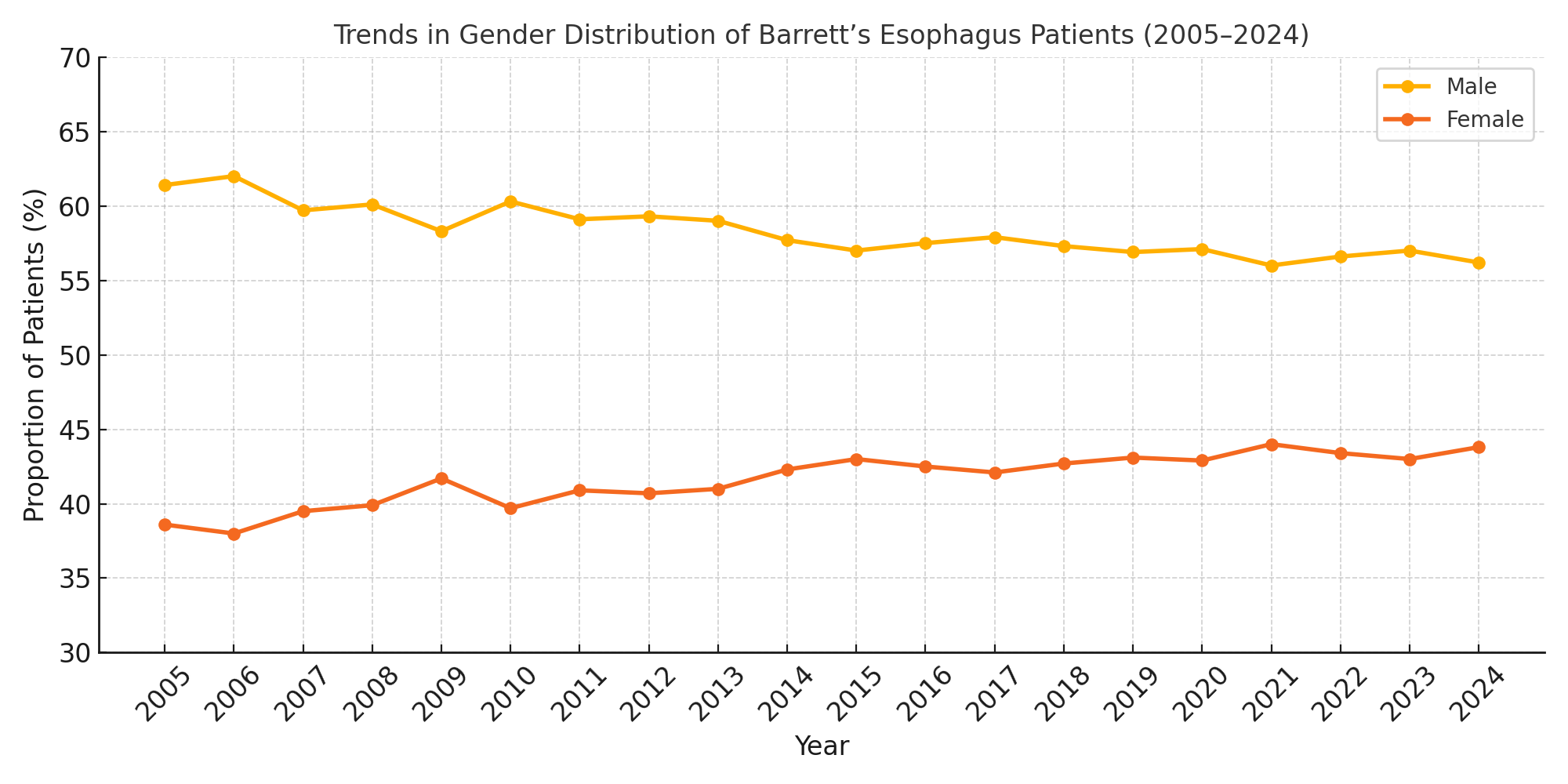Sunday Poster Session
Category: Esophagus
P0635 - Shifting Gender and Racial Trends in Barrett’s Esophagus: A 20-Year Analysis (2005-2024)
Sunday, October 26, 2025
3:30 PM - 7:00 PM PDT
Location: Exhibit Hall

Rishi Chowdhary, MD (he/him/his)
Case Western Reserve University / MetroHealth
Cleveland, OH
Presenting Author(s)
Rishi Chowdhary, MD1, Thai Hau Koo, MD2, Shivam Kalra, MBBS, MHA3, Ronnie Fass, MD, MACG4
1Case Western Reserve University / MetroHealth, Cleveland, OH; 2University of Sciences Malaysia Specialist Hospital, Kelantan, Kelantan, Malaysia; 3Trident Medical Center, North Charleston, SC; 4Division of Gastroenterology and Hepatology, Metrohealth Medical Center, Orange, OH
Introduction: Barrett’s Esophagus (BE) has historically been more prevalent in men; however, emerging evidence suggests a rising burden among women. We aimed to evaluate 20-year (2005–2024) trends in BE diagnoses with a focus on sex and racial/ethnic distribution among female patients.
Methods: We conducted a retrospective analysis of all Barrett’s Esophagus (BE) cases from 2005 to 2024 using the TriNetX Research Network, a large federated electronic health record (EHR) database. Patient gender and self-reported race/ethnicity were recorded annually. Temporal trends in the proportion of female vs. male patients and in the racial/ethnic composition of female BE patients were evaluated. The Cochran–Armitage trend test was used to assess linear trends over time, with a p value < 0.05 considered statistically significant.
Results: Males consistently comprised the majority of BE diagnoses; however, their representation declined from 61.4% in 2005 to 56.2% in 2024, while female representation rose from 38.6% to 43.8%, a net gain of 5.2 percentage points. This reflects an 8.5% relative decrease in male representation and a 13.5% increase among females. On average, males accounted for 58.1% and females for 41.9% of BE diagnoses after excluding patients with unknown gender. The Cochran–Armitage trend test confirmed a significant shift in sex distribution over time (p< 0.001), supported by Z-scores (female Z=10.933; male Z=–10.053).
Among female BE patients, White women constituted the majority (mean 83.6%), followed by, Black/African American (3.9%), and Asian (2.1%). Statistically significant increases were observed in the proportions of White (Z=10.489, p< 0.001), Black (Z=7.324, p< 0.001), and Asian (Z=3.081, p=0.002) women. In contrast, Native Hawaiian/Pacific Islander (Z=–11.365, p< 0.001) and the unknown race (Z=–22.050, p< 0.001) proportions declined significantly. No significant trend was observed among American Indian/Alaska Native women (Z=1.56, p=0.118).
Discussion: This 20-year trend analysis reveals a steady rise in BE diagnoses among women, particularly across White, Black, and Asian populations, signaling a shift from traditional male-dominated patterns. These findings underscore the need to re-evaluate screening strategies, ensuring equitable identification and surveillance of BE in women across diverse racial groups.

Figure: Trends in Gender distribution of Barrett's Esophagus patients (2005-2024)

Figure: Trends in Racial Distribution of Barrett's Esophagus Patients (2005-2024)
Disclosures:
Rishi Chowdhary indicated no relevant financial relationships.
Thai Hau Koo indicated no relevant financial relationships.
Shivam Kalra indicated no relevant financial relationships.
Ronnie Fass: BrainTree Labs/Sebela – Consultant. Carnot – Speaker. Daewoong – Consultant, Speaker. dexcal – Consultant. Megalab – Speaker. Phathom Pharmaceuticals – Advisory Committee/Board Member, Consultant.
Rishi Chowdhary, MD1, Thai Hau Koo, MD2, Shivam Kalra, MBBS, MHA3, Ronnie Fass, MD, MACG4. P0635 - Shifting Gender and Racial Trends in Barrett’s Esophagus: A 20-Year Analysis (2005-2024), ACG 2025 Annual Scientific Meeting Abstracts. Phoenix, AZ: American College of Gastroenterology.
1Case Western Reserve University / MetroHealth, Cleveland, OH; 2University of Sciences Malaysia Specialist Hospital, Kelantan, Kelantan, Malaysia; 3Trident Medical Center, North Charleston, SC; 4Division of Gastroenterology and Hepatology, Metrohealth Medical Center, Orange, OH
Introduction: Barrett’s Esophagus (BE) has historically been more prevalent in men; however, emerging evidence suggests a rising burden among women. We aimed to evaluate 20-year (2005–2024) trends in BE diagnoses with a focus on sex and racial/ethnic distribution among female patients.
Methods: We conducted a retrospective analysis of all Barrett’s Esophagus (BE) cases from 2005 to 2024 using the TriNetX Research Network, a large federated electronic health record (EHR) database. Patient gender and self-reported race/ethnicity were recorded annually. Temporal trends in the proportion of female vs. male patients and in the racial/ethnic composition of female BE patients were evaluated. The Cochran–Armitage trend test was used to assess linear trends over time, with a p value < 0.05 considered statistically significant.
Results: Males consistently comprised the majority of BE diagnoses; however, their representation declined from 61.4% in 2005 to 56.2% in 2024, while female representation rose from 38.6% to 43.8%, a net gain of 5.2 percentage points. This reflects an 8.5% relative decrease in male representation and a 13.5% increase among females. On average, males accounted for 58.1% and females for 41.9% of BE diagnoses after excluding patients with unknown gender. The Cochran–Armitage trend test confirmed a significant shift in sex distribution over time (p< 0.001), supported by Z-scores (female Z=10.933; male Z=–10.053).
Among female BE patients, White women constituted the majority (mean 83.6%), followed by, Black/African American (3.9%), and Asian (2.1%). Statistically significant increases were observed in the proportions of White (Z=10.489, p< 0.001), Black (Z=7.324, p< 0.001), and Asian (Z=3.081, p=0.002) women. In contrast, Native Hawaiian/Pacific Islander (Z=–11.365, p< 0.001) and the unknown race (Z=–22.050, p< 0.001) proportions declined significantly. No significant trend was observed among American Indian/Alaska Native women (Z=1.56, p=0.118).
Discussion: This 20-year trend analysis reveals a steady rise in BE diagnoses among women, particularly across White, Black, and Asian populations, signaling a shift from traditional male-dominated patterns. These findings underscore the need to re-evaluate screening strategies, ensuring equitable identification and surveillance of BE in women across diverse racial groups.

Figure: Trends in Gender distribution of Barrett's Esophagus patients (2005-2024)

Figure: Trends in Racial Distribution of Barrett's Esophagus Patients (2005-2024)
Disclosures:
Rishi Chowdhary indicated no relevant financial relationships.
Thai Hau Koo indicated no relevant financial relationships.
Shivam Kalra indicated no relevant financial relationships.
Ronnie Fass: BrainTree Labs/Sebela – Consultant. Carnot – Speaker. Daewoong – Consultant, Speaker. dexcal – Consultant. Megalab – Speaker. Phathom Pharmaceuticals – Advisory Committee/Board Member, Consultant.
Rishi Chowdhary, MD1, Thai Hau Koo, MD2, Shivam Kalra, MBBS, MHA3, Ronnie Fass, MD, MACG4. P0635 - Shifting Gender and Racial Trends in Barrett’s Esophagus: A 20-Year Analysis (2005-2024), ACG 2025 Annual Scientific Meeting Abstracts. Phoenix, AZ: American College of Gastroenterology.

